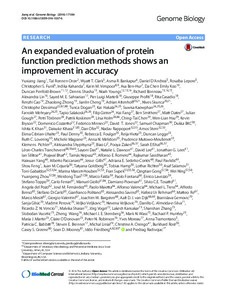An expanded evaluation of protein function prediction methods shows an improvement in accuracy
Jiang YX; Oron TR; Clark WT; Bankapur AR; D'Andrea D; Lepore R; Funk CS; Kahanda I; Verspoor KM; Ben-Hur A; Koo DCE; Penfold-Brown D; Shasha D; Youngs N; Bonneau R; Lin A; Sahraeian SME; Martelli PL; Profiti G; Casadio R; Cao RZ; Zhong Z; Cheng JL; Altenhoff A; Skunca N; Dessimoz C; Dogan T; Hakala K; Kaewphan S; Mehryary F; Salakoski T; Ginter F; Fang H; Smithers B; Oates M; Gough J; Toronen P; Koskinen P; Holm L; Chen CT; Hsu WL; Bryson K; Cozzetto D; Minneci F; Jones DT; Chapman S; Dukka BKC; Khan IK; Kihara D; Ofer D; Rappoport N; Stern A; Cibrian-Uhalte E; Denny P; Foulger RE; Hieta R; Legge D; Lovering RC; Magrane M; Melidoni AN; Mutowo-Meullenet P; Pichler K; Shypitsyna A; Li B; Zakeri P; ElShal S; Tranchevent LC; Das S; Dawson NL; Lee D; Lees JG; Sillitoe I; Bhat P; Nepusz T; Romero AE; Sasidharan R; Yang HX; Paccanaro A; Gillis J; Sedeno-Cortes AE; Pavlidis P; Feng S; Cejuela JM; Goldberg T; Hamp T; Richter L; Salamov A; Gabaldon T; Marcet-Houben M; Supek F; Gong QT; Ning W; Zhou YP; Tian WD; Falda M; Fontana P; Lavezzo E; Toppo S; Ferrari C; Giollo M; Piovesan D; Tosatto SCE; del Pozo A; Fernandez JM; Maietta P; Valencia A; Tress ML; Benso A; Di Carlo S; Politano G; Savino A; Rehman HU; Re M; Mesiti M; Valentini G; Bargsten JW; van Dijk ADJ; Gemovic B; Glisic S; Perovic V; Veljkovic V; Veljkovic N; Almeida-e-Silva DC; Vencio RZN; Sharan M; Vogel J; Kansakar L; Zhang S; Vucetic S; Wang Z; Sternberg MJE; Wass MN; Huntley RP; Martin MJ; O'Donovan C; Robinson PN; Moreau Y; Tramontano A; Babbitt PC; Brenner SE; Linial M; Orengo CA; Rost B; Greene CS; Mooney SD; Friedberg I; Radivojac P
An expanded evaluation of protein function prediction methods shows an improvement in accuracy
Jiang YX
Oron TR
Clark WT
Bankapur AR
D'Andrea D
Lepore R
Funk CS
Kahanda I
Verspoor KM
Ben-Hur A
Koo DCE
Penfold-Brown D
Shasha D
Youngs N
Bonneau R
Lin A
Sahraeian SME
Martelli PL
Profiti G
Casadio R
Cao RZ
Zhong Z
Cheng JL
Altenhoff A
Skunca N
Dessimoz C
Dogan T
Hakala K
Kaewphan S
Mehryary F
Salakoski T
Ginter F
Fang H
Smithers B
Oates M
Gough J
Toronen P
Koskinen P
Holm L
Chen CT
Hsu WL
Bryson K
Cozzetto D
Minneci F
Jones DT
Chapman S
Dukka BKC
Khan IK
Kihara D
Ofer D
Rappoport N
Stern A
Cibrian-Uhalte E
Denny P
Foulger RE
Hieta R
Legge D
Lovering RC
Magrane M
Melidoni AN
Mutowo-Meullenet P
Pichler K
Shypitsyna A
Li B
Zakeri P
ElShal S
Tranchevent LC
Das S
Dawson NL
Lee D
Lees JG
Sillitoe I
Bhat P
Nepusz T
Romero AE
Sasidharan R
Yang HX
Paccanaro A
Gillis J
Sedeno-Cortes AE
Pavlidis P
Feng S
Cejuela JM
Goldberg T
Hamp T
Richter L
Salamov A
Gabaldon T
Marcet-Houben M
Supek F
Gong QT
Ning W
Zhou YP
Tian WD
Falda M
Fontana P
Lavezzo E
Toppo S
Ferrari C
Giollo M
Piovesan D
Tosatto SCE
del Pozo A
Fernandez JM
Maietta P
Valencia A
Tress ML
Benso A
Di Carlo S
Politano G
Savino A
Rehman HU
Re M
Mesiti M
Valentini G
Bargsten JW
van Dijk ADJ
Gemovic B
Glisic S
Perovic V
Veljkovic V
Veljkovic N
Almeida-e-Silva DC
Vencio RZN
Sharan M
Vogel J
Kansakar L
Zhang S
Vucetic S
Wang Z
Sternberg MJE
Wass MN
Huntley RP
Martin MJ
O'Donovan C
Robinson PN
Moreau Y
Tramontano A
Babbitt PC
Brenner SE
Linial M
Orengo CA
Rost B
Greene CS
Mooney SD
Friedberg I
Radivojac P
BIOMED CENTRAL LTD
Julkaisun pysyvä osoite on:
https://urn.fi/URN:NBN:fi-fe2021042715680
https://urn.fi/URN:NBN:fi-fe2021042715680
Tiivistelmä
Background: A major bottleneck in our understanding of the molecular underpinnings of life is the assignment of function to proteins. While molecular experiments provide the most reliable annotation of proteins, their relatively low throughput and restricted purview have led to an increasing role for computational function prediction. However, assessing methods for protein function prediction and tracking progress in the field remain challenging.Results: We conducted the second critical assessment of functional annotation (CAFA), a timed challenge to assess computational methods that automatically assign protein function. We evaluated 126 methods from 56 research groups for their ability to predict biological functions using Gene Ontology and gene-disease associations using Human Phenotype Ontology on a set of 3681 proteins from 18 species. CAFA2 featured expanded analysis compared with CAFA1, with regards to data set size, variety, and assessment metrics. To review progress in the field, the analysis compared the best methods from CAFA1 to those of CAFA2.Conclusions: The top-performing methods in CAFA2 outperformed those from CAFA1. This increased accuracy can be attributed to a combination of the growing number of experimental annotations and improved methods for function prediction. The assessment also revealed that the definition of top-performing algorithms is ontology specific, that different performance metrics can be used to probe the nature of accurate predictions, and the relative diversity of predictions in the biological process and human phenotype ontologies. While there was methodological improvement between CAFA1 and CAFA2, the interpretation of results and usefulness of individual methods remain context-dependent.
Kokoelmat
- Rinnakkaistallenteet [27094]
